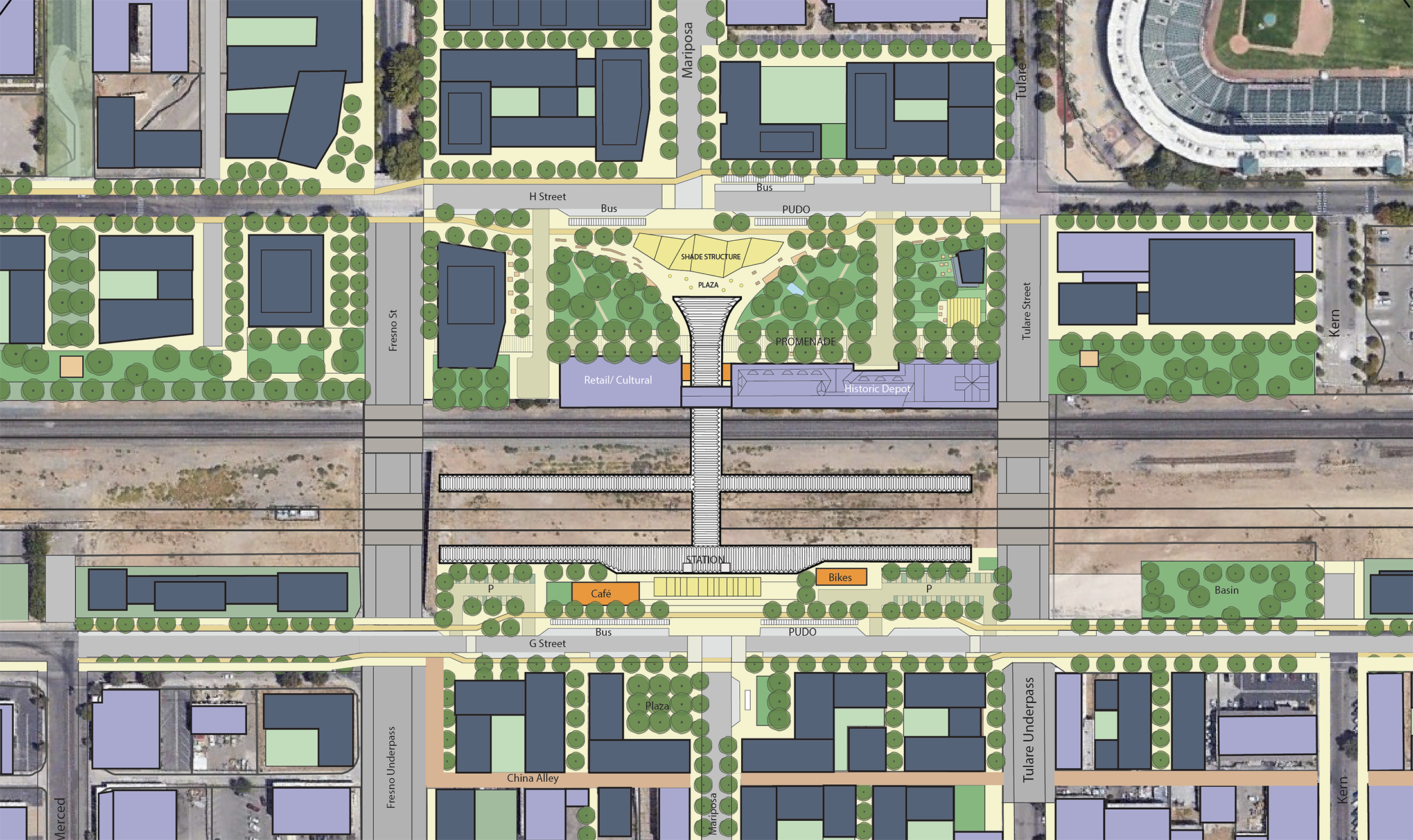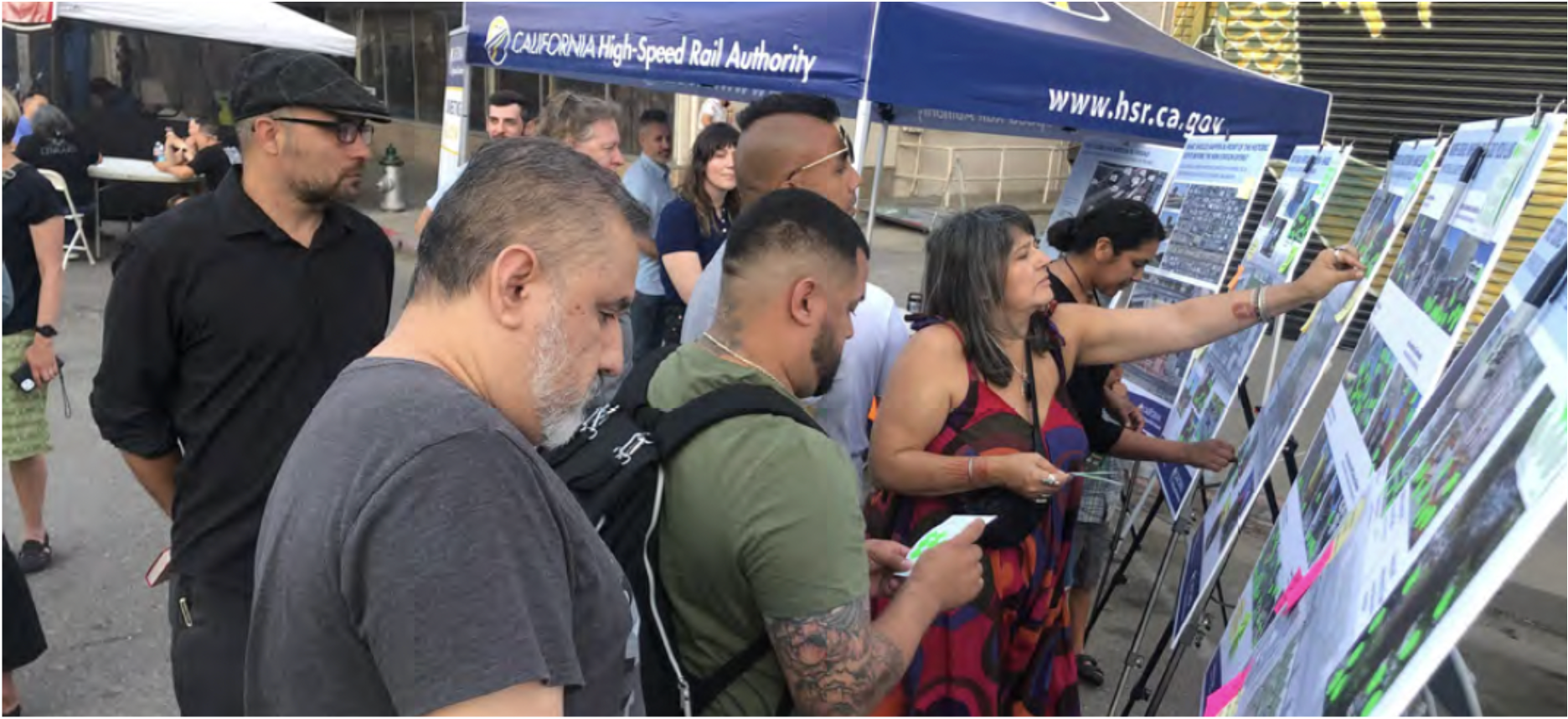California High-Speed Rail Station
Introduction
California High-Speed Rail (HSR) is a once-in-a-century sustainable transportation project that will bring high-speed rail to the U.S. for the first time. It will connect San Francisco with Los Angeles via the Central Valley, a 350-mile distance, in less than 3 hours with trains running up to 220 miles per hour. Not only will high-speed rail be transformative for the State of California by bringing regions closer together but also for the cities with stations along the line. In addition to providing a convenient and modern way of traveling, high-speed rail will be all electric, help cut carbon emissions and reduce the need for driving or flying between the major metropolitan areas. Since early 2020, Urban Field Studio has been collaborating with the California High-Speed Rail Authority (Authority) as part of the Deutsche Bahn (DB) Early Train Operator team to provide conceptual station site and station area planning, customer journey analysis, stakeholder and community engagement, and early site activation strategies and design.
The California High-Speed Rail Project
In 2008, the voters of California approved Proposition 1A that specified a route connecting all the major population centers of the state and provided the first funding for implementation. The route consists of three segments: the Central Valley segment connecting Merced with Bakersfield, which will be the first segment to operate starting in 2030, the northern segment between Merced and San Francisco and the southern segment between Bakersfield and Anaheim, both of which will operate in later phases.The Central Valley trackway is currently under construction and will be at grade or on an elevated viaduct structure. Many cities with stations along the HSR line have prepared vision plans for station districts and local transit access to respond to the future opportunities that HSR presents.
The Challenge/Opportunity
A transportation project of this scale is highly complex and takes decades to plan and build. Planning includes environmental clearances, land acquisitions, coordination with cities, agencies and stakeholders, including legal, financial, and technical challenges. The project has now progressed to station design for four stations and station area planning for several more stations. Now the leaders in each city are starting to think about what kind of urban place the station and its surroundings should become in order to benefit their community. HSR stations should be catalysts for opportunities and change, particularly in cities that have historically seen a lack of investment and are facing many challenges.
Urban Field Studio was brought onto the team to help envision what the future station and its surrounding districts could be. Our charge included what uses should be at the station, how passengers would get to and from the station with ease, and most importantly, how the station would fit into the future context and evolve over time. Our many roles have involved listening, facilitating, and illustrating possibilities.
The goal is to create a fully integrated station that provides world-class service in a people-friendly environment, which is in line with each city’s vision. To date, the team has developed studies and concept plans for the stations in Fresno, Bakersfield, Kings-Tulare, Gilroy, and Palmdale. These concepts serve as inspiration for the next design phase that will include more detailed planning.
In Fresno the team, together with BASE Landscape Architects, has created an early site activation design for the plaza in front of the Historic Depot that will be an attractive open space for the community before the new station construction begins. The design process included stakeholder and community engagement at local events to ensure that the plaza offers elements and amenities that are important to the community.
Why did the California High-Speed Rail Authority choose the DB/Urban Field Studio Team?
Deutsche Bahn operates one of the largest rail networks in Europe, and has extensive experience with transit-centered development, building and operating track systems and stations, mobility and other services. They provide consulting and engineering services for rail projects all over the world. Urban Field Studio is complementing DB’s technical expertise with decades of experience in station area planning around BART, LRT, and HSR stations.
Urban Field Studio’s ability to work with complex challenges and large teams and apply our extensive knowledge about how to translate ideas into design for urban human-centered places was the primary reason we were brought on the team. Always being flexible to assist with ad-hoc needs and never taking off our creative lenses was another. We have helped the Authority to articulate and communicate how a station would function in its urban context and what kind of experience it could provide. We brought focus to urban design issues and their visual representation, which was a departure from the mostly technical work that had been done to date. Our work has made the HSR project more tangible and accessible to each community, creating excitement about the realization and potential of this exceptional project. At the same time, our planning has helped to lay the groundwork for the next steps in the implementation process.
As a small team, Urban Field Studio was able to provide a highly-personalized service and build a close relationship with the larger HSR team and the Authority’s planning leadership. We have responded quickly to varied requests, often on short notice. We use a variety of tools such as sketching, 3-D modeling, plan graphics, presentations, and precedents, to convey ideas. We analyze existing conditions and conduct research on precedents to inform a context-sensitive approach. We help with structuring and facilitating conversations, and put ideas from workshops to paper. We do all of this with a passion for HSR and the belief in a future of cities that can be more sustainable, more humane, and more livable.
The Results
We have created many presentations and materials to support meetings, discussions and decisions. We have generated studies, plans, and illustrations to advance planning, placemaking, and site development options. We have produced a report for the Fresno Early Site Activation Historic Depot Plaza that helped secure grant funds for implementation.
All Case Studies
All Featured Projects
Other Projects
Scotts Valley Town Center Specific Plan Update
Alisal District Identity Master Plan
Belmont Harbor Industrial Area Specific Plan
Dublin Downtown Vision
Irvington BART Station Area Plan
San Leandro Multi-Family Development Standards
Emeryville Objective Design Standards
Vision for Downtown Santa Clara Workshops
Fremont Mission San Jose Commercial Strategy Study
Coliseum Study
San Pablo Avenue Specific Plan
Burlingame Town Square
Port of Redwood City Studies
Delta Community Design Charrettes
Diamond Bar Comprehensive General Plan Update
Oakland Wayfinding
Vermont Santa Monica Station Feasibility Study
Urban Field © 2024
Made with ♡ by SuperWorks





